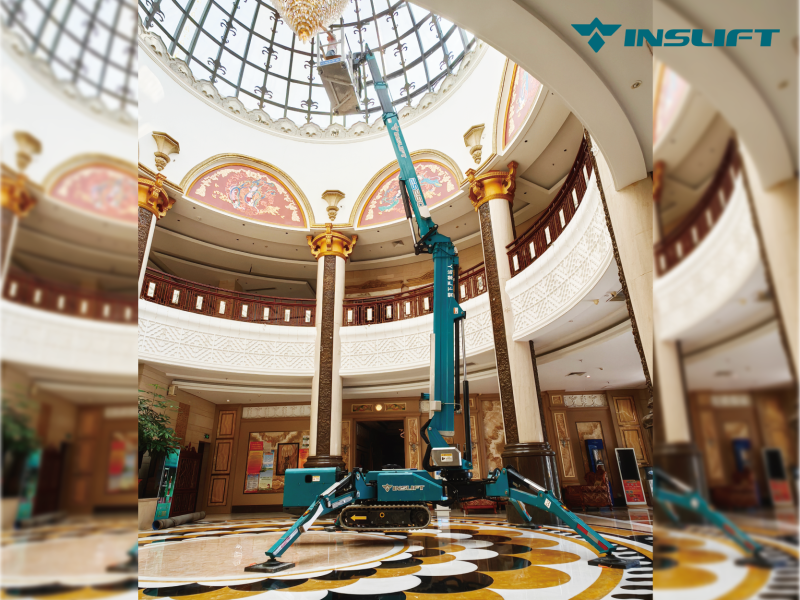This article is reprinted from CNNLIFT, published by CNNLIFT on June 19, 2022. Original link: https://cnnlift.com/ShangyeZhongxin.html
With the expansion of the spider lift rental business, more and more industries are gradually realizing the importance of spider lifts for indoor operations, especially in the widespread use within commercial shopping centers. When aerial equipment rental companies provide leasing services for commercial shopping centers, business managers need to constantly verify various data within the mall to avoid providing spider lifts that do not meet on-site usage requirements. This not only fails to provide various operational solutions for the mall but also causes damage to the mall. Therefore, when providing spider lifts for commercial complexes, attention should be paid to the following points:
The working height must be considered for all aerial operations, which is a fundamental parameter, so I'll place this factor first. However, based on many years of experience within this industry, many rental companies and business managers sometimes oversimplify the consideration of working height. They may think that as long as the lift can reach the work point, it's sufficient. However, the site conditions are often complex; choosing a lift that just fits the height requirement may not be enough on-site due to other obstacles. Therefore, when choosing a spider lift, site factors and operational redundancy must be considered. Furthermore, clients should also be aware that higher lifts have a direct impact on improving work efficiency.
Some shopping malls were constructed a long time ago, and at that time, there was no consideration of using various aerial work platforms for assistance. Therefore, the designed floor load of some malls may be relatively small. Although the weight of spider lifts is much lighter than conventional boom lifts, the overall weight of the machine still exerts pressure. Additionally, the weight of spider lifts varies depending on the brand, specifications, and height. Therefore, when choosing a spider lift, the floor load of the mall must be determined to prevent damage to the entire mall's building structure.
Since spider lifts originated in European and American countries and have been widely used in their markets, it was only introduced to China in the past decade or two. Especially ten years ago, spider lifts were not widely accepted by designers in China, and imported spider lifts from Europe and the United States were expensive. Therefore, when many shopping malls were initially designed, they did not consider the use of spider lifts, but instead chose compromise solutions such as scaffolding and high-altitude ropes for high-altitude maintenance. Therefore, entrances, steps, aisles, and high-altitude spaces were not considered for the use of spider lifts. When providing spider lift rentals for shopping malls, it is necessary to verify the conditions of various passages on-site to avoid the embarrassment of the spider lift being unable to reach the work point after arriving on-site.
Passage size is one of the most common reasons for the failure of rental service companies' leasing services. With a combination of various models, suitable, safe, and reliable leasing services can be provided for different shopping malls.
For high-altitude work, it is necessary to clearly determine the positions and surfaces where high-altitude work are required in order to select the appropriate spider lift model and successfully complete the operation. Because different brands, models, heights, and designs of spider lifts result in differences in the support range of the lift outriggers, without a site survey, selecting based solely on the working height can easily lead to the lift being unable to reach some work points and surfaces, resulting in dissatisfaction from property companies.
Spider lifts have various arm structures such as straight arm, double telescopic arm, and articulated arm. Different arm structures are suitable for different workspaces. For example, straight arm structures are suitable for open spaces; double telescopic arm structures have the advantage of large spans and are suitable for places where obstacles need to be crossed; articulated arm structures are suitable for overlapping high-altitude spaces. Therefore, the consideration of high-altitude workspace is to choose the appropriate arm structure of the spider lift, so as to smoothly carry out on-site operations.
All in all, when providing spider lifts for commercial complexes, business managers need to pay attention to key factors such as operating height, ground load, passage size, high-altitude work points, and workspaces. Only by comprehensively considering these points can suitable, safe, and reliable leasing services be provided, thus providing effective solutions for high-altitude operations in shopping malls and promoting the development of commercial complexes.

